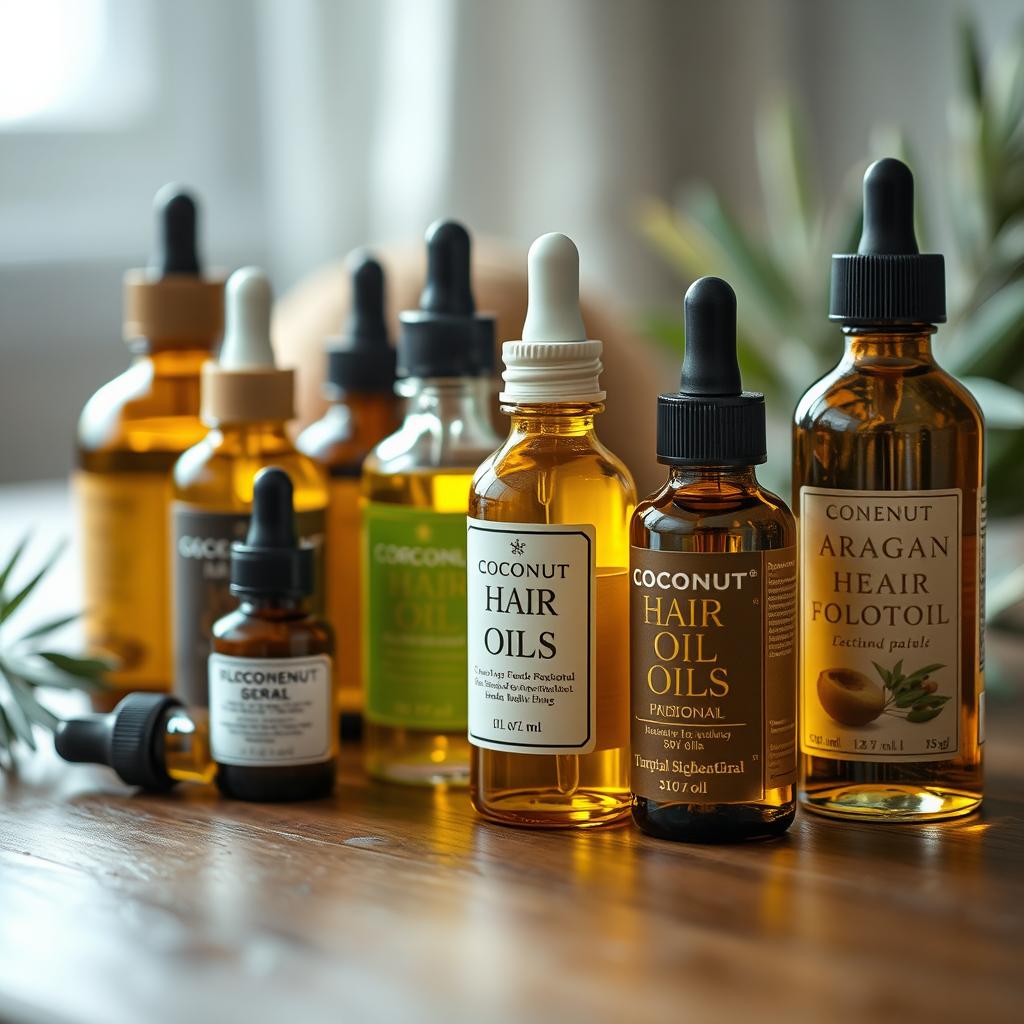Are you tired of dealing with dull, damaged hair? We’re excited to share how you can transform your locks into vibrant, healthy hair in just one week using natural oils!
For centuries, oils have been used as effective hair treatments, offering deep nourishment and repair. By applying the right oil to your scalp, you can promote growth and improve the overall health of your hair. Simple application methods can be easily incorporated into your weekly routine to maximize the benefits.
Key Takeaways
- Nourish your hair with the right oils for healthy growth.
- Discover simple application methods for maximum benefits.
- Learn how to address common hair concerns like dryness and scalp issues.
- Transform your dull, damaged hair into vibrant, healthy locks.
- Promote hair health and growth with natural oils.
The Power of Natural Oils for Hair Rejuvenation

We’ve discovered that natural oils can be a game-changer for hair health, providing nourishment and protection. When applied to the scalp, certain natural oils can calm irritation, fight off unwanted bacteria that cause scalp issues, deliver important fatty nutrients directly to the hair root, and stimulate blood flow. This multifaceted approach to hair care is what makes natural oils so effective.
Why Natural Oils Are Effective for Hair Health
Natural oils are rich in essential nutrients, vitamins, and fatty acids that hair craves for optimal health. Unlike synthetic products, these oils penetrate deep into the hair shaft, providing nourishment from within rather than just coating the surface. The therapeutic properties of these oils extend beyond just hair strands to nourish the scalp, creating the optimal environment for healthy hair growth.
Many natural oils contain antioxidants that protect hair from environmental damage and free radicals that contribute to hair aging. By restoring hair’s natural moisture balance, natural oils help maintain elasticity and prevent breakage, ultimately leading to healthier and more resilient hair.
How Natural Oils Transform Damaged Hair
The molecular structure of natural oils allows them to fill gaps in damaged hair cuticles, helping to repair and strengthen weakened strands. Regular use of natural oils can restore hair’s natural moisture balance, which is crucial for maintaining elasticity and preventing breakage. As a result, even severely damaged hair can be transformed by rebuilding its structural integrity and restoring its natural shine and bounce.
By improving hair health through the use of natural oils, individuals can enjoy more vibrant and manageable hair. The properties of these oils make them an indispensable part of a comprehensive hair care routine.
Understanding Hair Oils: Carrier vs. Essential Oils
To unlock the full potential of hair oils, it’s vital to comprehend the distinction between carrier and essential oils. Natural oils have been a cornerstone of hair care for centuries, offering a myriad of benefits for hair and scalp health. The key to effective hair treatment lies in understanding the roles of carrier and essential oils.
What Are Carrier Oils?
Carrier oils are extracted from the fatty parts of plants, such as seeds, nuts, and fruits. They are typically thick and odorless, making them an excellent base for hair treatments. Carrier oils are rich in nutrients and are particularly beneficial for hydrating the scalp. Examples include coconut oil, olive oil, and jojoba oil. These oils are generally mild and can be applied directly to the hair and scalp without dilution.
Here’s a brief overview of the characteristics of carrier oils:
| Characteristics | Description |
|---|---|
| Source | Fatty parts of plants (seeds, nuts, fruits) |
| Texture | Thick |
| Scent | Odorless or mild |
| Usage | Can be applied directly to hair and scalp |
What Are Essential Oils?
Essential oils, on the other hand, are highly concentrated extracts derived from flowers, leaves, and stems. They are potent and fragrant, containing the “essence” of the plant. Due to their high concentration, essential oils must be diluted with carrier oils before application to avoid irritation. Examples include rosemary oil, tea tree oil, and lavender oil. When used correctly, essential oils can provide therapeutic benefits for specific hair and scalp concerns.
Here’s a summary of the key differences between carrier and essential oils:
| Oil Type | Source | Concentration | Usage |
|---|---|---|---|
| Carrier Oils | Fatty parts of plants | Mild | Direct application |
| Essential Oils | Flowers, leaves, stems | Highly concentrated | Diluted with carrier oils |
5 Natural Oils That Revive Your Hair in One Week
We’ve curated 5 natural oils that can dramatically improve your hair’s health in one week. These oils work synergistically to address various hair concerns, from dryness to damage.
How These Oils Work Together
The 5 natural oils we’ve selected – including avocado oil and lavender oil – complement each other by targeting different aspects of hair health. When used together, they create a comprehensive treatment that nourishes your hair from root to tip. For instance, some oils moisturize, while others stimulate hair growth or protect against damage.
These oils are extracted from nuts, seeds, and fruits, and are rich in nutrients. When massaged onto the scalp, they increase blood flow and stimulate hair follicles, promoting healthy hair growth.
| Oil | Benefits for Hair |
|---|---|
| Avocado Oil | Moisturizes and nourishes hair |
| Lavender Oil | Promotes hair growth and reduces dandruff |
| Coconut Oil | Hydrates and protects hair |
What to Expect in One Week
In the first few days, these oils work to deep cleanse and prepare your scalp and hair for optimal nutrient absorption. By mid-week, you can expect your hair to become more manageable with reduced frizz and increased shine. As you continue the treatment, the oils seal in moisture, strengthen the hair shaft, and protect against future damage.
After a week of consistent use, most people experience visibly healthier hair with improved texture, shine, and resilience. These oils are effective for all hair types, though application methods may vary based on your specific hair texture and concerns.
Coconut Oil: The Ultimate Moisture Booster

As a natural and effective hair care solution, coconut oil offers numerous benefits that can transform your hair health. We’re excited to dive into the advantages of using coconut oil for your locks!
Benefits for Hair Health and Growth
Coconut oil is a tropical wonder that’s rich in medium-chain fatty acids, particularly lauric acid, which has a unique ability to penetrate the hair shaft unlike most other oils. This characteristic makes coconut oil an excellent choice for deep moisture restoration. Research shows that coconut oil can reduce protein loss in both damaged and undamaged hair, helping to strengthen strands from within.
- Coconut oil is our top recommendation for deep moisture restoration, and we’ve seen amazing results with consistent use!
- Beyond moisture, coconut oil creates a protective barrier that shields your hair from environmental damage, heat styling, and UV exposure.
- The antimicrobial properties of coconut oil also help maintain a healthy scalp environment, addressing issues like dandruff and itchiness.
By incorporating coconut oil into your hair care routine, you can expect to see improvements in hair elasticity, reduced breakage, and healthier growth.
How to Apply Coconut Oil to Your Hair
For maximum benefits, we recommend warming the coconut oil slightly before application to enhance penetration into the hair shaft. To do this, simply place a teaspoon of oil into a cup and put the cup into a bowl partially filled with hot tap water. You can also rub a teaspoon of oil between your hands to melt it. Apply the coconut oil directly to your hair and scalp, making sure to cover all areas evenly.
Leave the oil in for at least 30 minutes before shampooing and rinsing. For an intense treatment, consider leaving it on overnight and washing it out in the morning. Regular use, such as a weekly coconut oil treatment, can dramatically improve your hair’s overall health and appearance.
Tea Tree Oil: The Scalp Revitalizer

When it comes to tackling scalp issues, tea tree oil is our top pick! This powerful essential oil has been shown to reduce dandruff caused by seborrheic dermatitis, thanks to its rich content of aromatic compounds called terpenes. These terpenes have antimicrobial properties that resist the attachment of yeasts, making tea tree oil an effective treatment for various scalp conditions.
Promoting Healthy Hair Growth
Tea tree oil is particularly effective for addressing dandruff, seborrheic dermatitis, and itchy scalp – common issues that can impede hair growth. By clearing away dead skin cells, excess sebum, and product buildup, tea tree oil helps to unclog hair follicles, creating a healthier environment for hair to grow. Regular application can balance scalp oil production, making it beneficial for both oily and dry scalp conditions.
The oil works by creating the optimal scalp environment for new hair growth and strengthening existing follicles. Many of our readers report noticing a cleaner, less itchy scalp after just one or two applications of tea tree oil treatments.
Application Methods
To use tea tree oil effectively, mix a few drops with a carrier oil like coconut, almond, or sesame oil. Avoid applying tea tree oil directly to the scalp, as this can cause irritation. Instead, massage the mixture onto your dry scalp and follow with your normal shampooing routine.
Because tea tree oil is highly potent, we recommend diluting it with a carrier oil – typically 2-3 drops per tablespoon of carrier oil is sufficient. This ensures you reap the benefits while minimizing the risk of irritation.
Rosemary Oil: The Growth Stimulator

When it comes to hair growth, rosemary oil is a natural remedy that’s hard to ignore. We’ve seen numerous studies highlighting its potential, and we’re excited to dive into the details.
Scientific Evidence for Hair Growth Benefits
Research has shown that rosemary oil can be as effective as minoxidil, a common medication for androgenic alopecia, in promoting hair growth. A clinical trial involving 100 participants found that rosemary oil, when applied to the scalp, resulted in similar hair growth outcomes as minoxidil but with fewer side effects. The key to rosemary oil’s success lies in its ability to improve blood flow to the scalp, thereby supporting hair follicle health.
The magic of rosemary oil doesn’t stop there. It’s also been found to block DHT (dihydrotestosterone), a hormone that contributes to hair thinning and loss. Additionally, rosemary oil contains antioxidants that protect hair follicles from damage and premature aging, making it a potent tool in the fight against hair loss.
Best Ways to Use Rosemary Oil
To harness the benefits of rosemary oil for hair growth, it’s essential to use it correctly. We recommend diluting 5-10 drops of rosemary oil with a tablespoon of a carrier oil, such as coconut or almond oil, and gently massaging it into your dry scalp. Leave the mixture on for at least 30 minutes before washing your hair as usual with a mild shampoo.
Consistency is key when using rosemary oil. While you may notice improvements within a week, the most dramatic results come with regular use over several months. We’re confident that with patience and the right application, rosemary oil can become a valuable addition to your hair care routine.
Jojoba Oil: The Balancing Treatment

Jojoba oil is a game-changer for hair care, offering a unique balancing treatment that works wonders for various hair types. We’re excited to dive into the benefits of jojoba oil and explore how it can transform your hair care routine.
How Jojoba Oil Mimics Natural Scalp Oils
Jojoba oil’s molecular structure closely resembles our scalp’s natural sebum, making it an ideal treatment for balancing oil production. This remarkable similarity allows jojoba oil to add moisture to dry scalps while helping to regulate overproduction in oily scalps. As a result, jojoba oil is perfect for all hair types, including fine hair that gets weighed down easily. The oil penetrates the hair shaft effectively, delivering moisture without leaving a heavy residue on the surface.
Jojoba oil is also rich in powerful vitamins and minerals, including vitamin E, B-complex vitamins, and zinc, which nourish both the hair and scalp. For those struggling with scalp conditions, jojoba oil’s anti-inflammatory properties can soothe irritation and reduce flakiness, promoting a healthier scalp environment.
Jojoba Oil Application Techniques
To get the most out of jojoba oil, we recommend applying it to damp hair after washing to seal in moisture and protect against heat damage from styling tools. For an intensive treatment, massage warm jojoba oil into your scalp and through your hair, leave it on for 30-60 minutes, then shampoo as usual. You can also mix 1 teaspoon of jojoba oil with 2 tablespoons of castor oil for an extra nourishing treatment.
By incorporating jojoba oil into your hair care routine, you can say goodbye to dry, damaged hair and hello to a healthier, more balanced scalp. Give jojoba oil a try and experience the benefits for yourself!
Olive Oil: The Deep Conditioner

When it comes to deep conditioning, olive oil is one of the most effective natural remedies available. We’ve seen firsthand how it can transform dry, damaged hair into soft, manageable locks.
Olive Oil’s Nourishing Properties
Olive oil is rich in monounsaturated fats, which contain conditioning properties that penetrate and moisturize parched strands. This kitchen staple is packed with antioxidants, vitamins A and E, and fatty acids that nourish and strengthen hair from within. We’re particularly impressed by olive oil’s ability to penetrate the hair shaft deeply, delivering moisture to the cortex where it’s needed most.
For coarse, thick, or curly hair types that tend to be dry, olive oil is an absolute game-changer for adding softness and manageability. The squalene in olive oil helps to seal moisture into the hair shaft while adding a beautiful, healthy shine without greasiness.
Effective Olive Oil Hair Treatments
To get the most out of olive oil, we recommend using extra virgin olive oil (EVOO) for hair treatments, as it contains the highest levels of beneficial compounds and antioxidants. To apply, warm the olive oil slightly by placing the container in a warm bowl of water. Then, apply it to the driest parts of your hair and gently massage it onto the scalp, being cautious not to overdo it if your scalp tends to be oily.
Leave the olive oil treatment on your hair for 30 minutes before shampooing it out, and condition as normal. A weekly olive oil treatment can dramatically improve hair elasticity, reducing breakage and split ends while promoting length retention. For maximum benefits, focus on the mid-lengths to ends where dryness and damage are most common.
Maximizing Results: Best Practices for Oil Treatments
When it comes to hair oil treatments, technique and timing are just as crucial as the oils themselves. We’ve discovered that understanding how to apply these treatments effectively can make all the difference in achieving healthier, more vibrant hair.
Timing Your Oil Treatments
The timing of your oil treatments can significantly impact their effectiveness. For optimal absorption, we recommend applying oil treatments to slightly damp hair rather than completely wet or dry hair. Different hair types benefit from different timing strategies – fine hair may only need 30 minutes, while thick, coarse hair can benefit from longer treatments, even overnight!
For enhanced penetration, try the “warm towel method” – apply oils, then wrap your hair in a towel that’s been warmed in the dryer for a few minutes. The frequency of oil treatments should vary based on your hair’s needs – very dry hair might benefit from twice-weekly treatments, while oilier hair types may only need one treatment every 1-2 weeks.
| Hair Type | Recommended Treatment Time | Frequency |
|---|---|---|
| Fine Hair | 30 minutes | Once a week |
| Thick/Coarse Hair | Overnight | Twice a week |
| Oilier Hair | 30 minutes to 1 hour | Every 1-2 weeks |
Combining Oils for Enhanced Benefits
Creating custom oil blends allows you to address multiple hair concerns simultaneously. By mixing different oils, you can tailor your hair treatment to your specific needs. For example, combining coconut oil with rosemary oil can help stimulate hair growth while moisturizing your locks.
Start with a small amount and add more as needed, as excess oil can be difficult to remove and weigh hair down. Some popular combinations include mixing a few drops of tea tree oil with jojoba oil for a scalp-revitalizing treatment or blending olive oil with coconut oil for an intense moisturizing treatment.
Conclusion: Your Path to Healthier Hair
Incorporating these five natural oils into your routine can be a game-changer for your hair health! We’re confident that with consistent use, you’ll not only see improvements within a week but also experience long-term benefits like reduced hair loss and dandruff.
Each oil offers unique benefits, from coconut oil’s moisturizing properties to tea tree oil’s scalp revitalization. Together, they create a comprehensive hair care strategy that fosters hair growth and strengthens your locks.
To maximize results, remember to be patient and adjust your usage based on your hair’s response. With these natural oils, you’re not just treating current hair concerns; you’re also preventing future damage. Here’s to achieving healthier, more beautiful hair through the power of nature!


